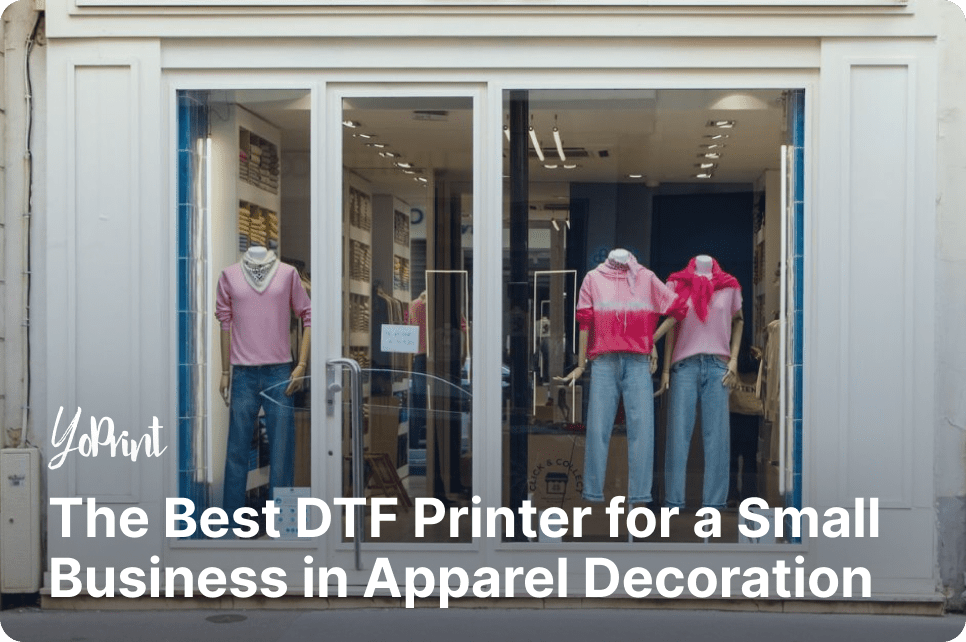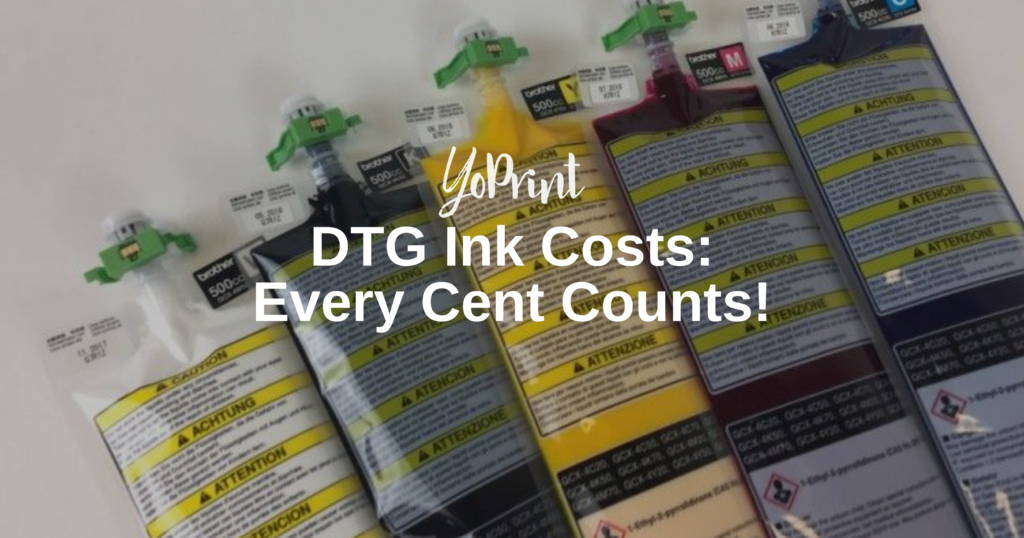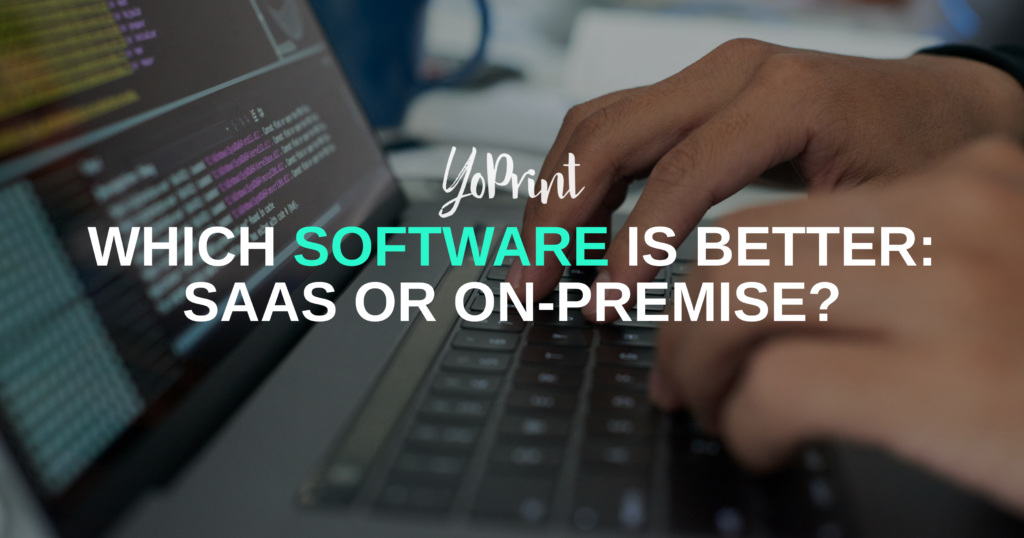Direct-to-film (DTF) printing has really made a strong impression on the custom apparel decoration industry. It’s quickly become a more popular option for entry-level custom apparel printing than the more expensive direct-to-garment (DTG) option. Given DTF’s comparable quality to DTG printing and at a fraction of the overall entry costs, it’s no wonder why people are flocking to DTF printing.
Are you starting your own small print business? DTF is a great way to get started; we’ve got a detailed article to help you with that. One important consideration to bear in mind is the DTF printer you’ll be using. You’ll have plenty of options available to you, but making a decision can be tricky – especially when you have a limited budget. We’ll lend you a hand with this article on the best DTF printer for a small business.
Start Small
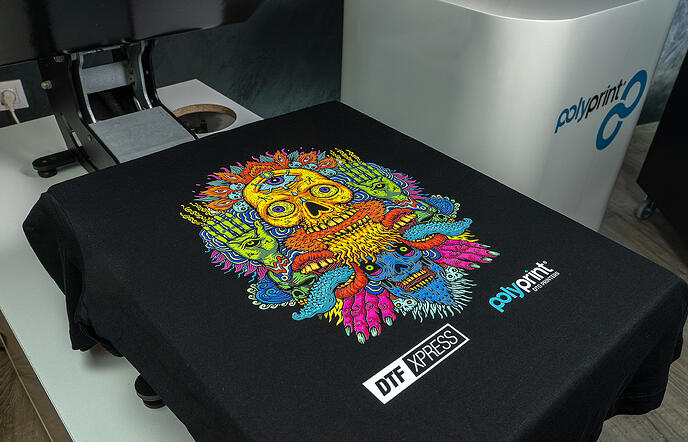
DTF printing is a heat transfer printing method where you print a design onto a special transparent film and then apply an adhesive powder that needs to be melted before it can be applied to a garment. The versatility of its easy application makes it a great choice when you’re starting small, primarily because you won’t be limited to custom apparel only. You can even print designs and sell them as-is so people can apply these designs to whatever they wish.
For budget-conscious small business owners like yourself, starting out doesn’t require you to make a hefty investment. Entry-level DTF printers are well within your reach, either in the form of affordable converted printers or through easy financing or leasing for a dedicated DTF printer.
The Converted Printer
A converted DTF printer, sometimes called a repurposed DTF printer, is essentially a standard desktop inkjet printer that’s been converted to be able to print for DTF applications, hence the name. Most of the standard components of the inkjet printer are completely replaced in order to allow it to print on DTF transfer films. You can easily buy a converted printer online, or you can even convert one on your own through the help of many tutorial videos uploaded to YouTube.
A converted printer is a solid foundation for basic DTF printing requirements without needing extensive DTF printing knowledge. Most converted printers have the necessary tools you’ll need, with some bundling raster image processor (RIP) software for managing your color output and print quality. Since they’re about the same size as a desktop inkjet printer, you can easily fit it almost anywhere, making it ideal for home businesses as well.
The Advantages of a Converted Printer

Easy to acquire: During the DTG popularity boom, there were plenty of converted DTG printers that allowed entry-level printers to start custom apparel decorating on a budget. With DTF’s versatility and lower entry costs, converted DTG printers are a very rare sight these days, while converted DTF printers have grown in popularity. Search sites like Amazon and you’ll find a wide selection of converted printers to choose from.
The same applies to standard desktop inkjet printers that are used for conversion. Commonly used models include the Epson P800 and Epson EcoTank L1800 due to their low price and ease of access to spare parts.
Budget-friendly: An entry-level DTG printer can still set you back at least $3,500 just for the printer alone. With a converted DTF printer, you’ll only be paying a fraction of that price; you might even find converted printers sold between $500 to $1,000. If you’re lucky, you can also find a bundled offer – which may include the printer, a heat press, and a few starting consumables (ink, PET transfer films, hot melt adhesive powder) – for around that price point, if not for less than $2,000 in some cases.
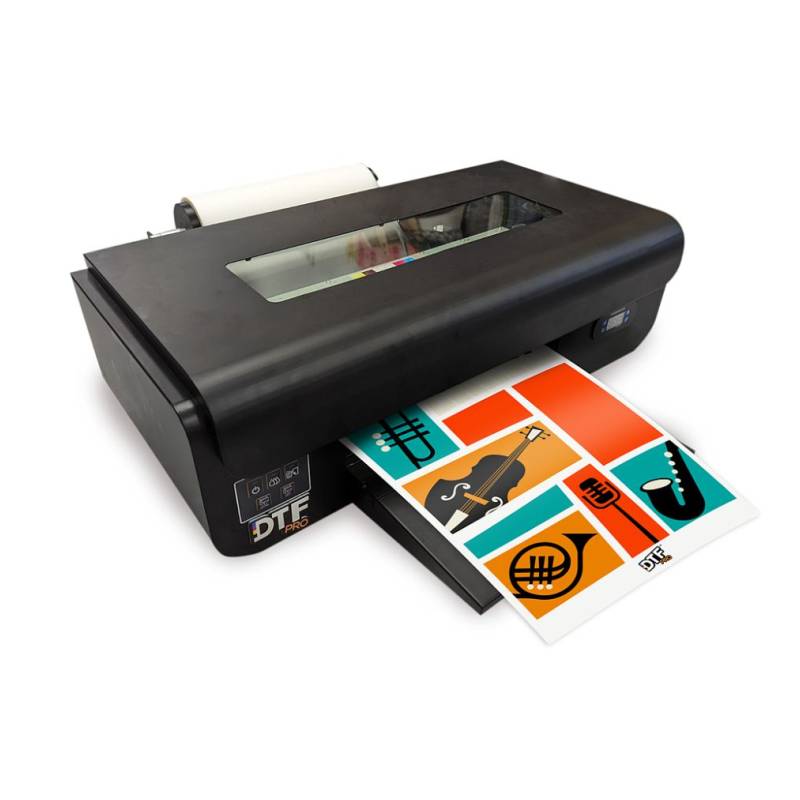
Works with compatible inks: Much like the converted printers themselves, you’ll find a wide variety of compatible CMYK inks that will work with most converted printers. It’s always a good idea to check with the ink supplier first to determine whether the inks will work nicely with your converted printer. You should ideally do a test run any time you get new inks that you’ve not used before.
While a desktop inkjet printer technically can print for DTF applications, the CMYK inks they used have some differences from DTF’s CMYK inks. As such, converted printers replace the standard ink system to support DTF CMYK inks instead. This ensures you get accurate color matching and great color vibrancy needed for various substrate applications.
Disadvantages to Converted Printers

Parts sourcing: Converted printers are an amalgamation of different components sourced from different machines, and therein lies the problem. If your printer breaks down at any time, you can expect to have a hard time trying to find the replacement parts you need, especially for components that are non-standard for that particular converted printer.
You’d be better off saving yourself the trouble (and the cost) of looking for replacement parts, more so if it’s an obsolete model you’re using.
Tedious self-maintenance: Even if you can find the parts you need, repairing and maintaining the converted printer can be a time-consuming process. For one, you don’t have a user manual to go with the printer since it’s been heavily modified; some instructions will be provided, but only for completing DTF printing tasks and some basic maintenance.
If anything were to go wrong, you’d have a hard time assessing the problem or even finding a way to fix it. There are tutorials online you can consult, but there’s a risk their solutions won’t work, either because you’re not sure how to fix the problem or it may be due to something else entirely. You could end up spending countless hours working on the printer and make no progress at all. That’s time that could have been used to grow your business!
Reliability concerns: Because of the mishmash of parts and the dilemma of maintenance when the printer breaks down, reliability becomes a particular concern if you’re hoping to make the most of your converted printer for your home business. Some users have reported their converted printer working nicely for a few years, while others have found that theirs broke down completely after just a few months.
Unexpected issues: Beyond component breakdowns, you might run into other unexpected hiccups along the way. This could be as simple as a jam during printing to a more troubling experience like DRM issues. The latter problem may be more likely than you think, considering a converted printer is made up of so many different components that don’t actually match.
Dedicated DTF Printers
Unlike converted printers, dedicated DTF printers were built specifically to service DTF printing applications. Think of them as being in the same class as the entry-level DTG printers like Ricoh’s Ri 100 model. That means you won’t have to deal with various reliability issues and have access to support channels that can help you resolve printer downtime quickly.
Most dedicated DTF printers are usually hovering around the same price range as entry-level DTG printers – that is, from $3,000 and above. For a lot of small businesses, $3,000 can feel like a major investment. Thankfully, you can also find a decent bundled package that includes the printer, all the necessary consumables, and a heat press for a decent price point.
Ultimately, getting a dedicated printer is more of a long-term investment since you can get support for any breakdowns you might experience during its use. You won’t have to worry the way you do when handling a converted printer. Even then, the entry-level DTF printer is also a foundation for your printing journey; later down the line, you’ll still need to upgrade to something better to keep up with growing demand.
UNINET 100 DTF ($3,995)
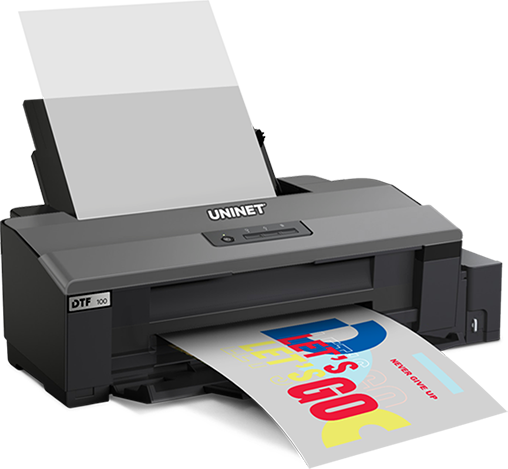
- Pros: Uses toner cartridges that are easy to swap, diverse printing capabilities, base package comes with a starter kit and training
- Cons: Difficult ink setup/refill process, needs two power sources, requires frequent use, needs to be in a well-ventilated area
While part of us is convinced this might be a converted printer, UNINET is a known brand that’s famous for its excellent white toner printers. The UNINET 100 DTF is an affordable option for starting with DTF printing and only requires a relatively small footprint. Buying the printer will also net you a number of extras in the provided starter package, including inks, hot melt adhesive powder, RIP software, and useful accessories; you also get free “master class” training to help you with using the printer, along with a 30-minute remote Q&A session for getting the printer set up.
For its price point, that’s a fairly generous offer indeed. This means that you can get started a lot quicker with the onboarding and training you get. On top of that, you also get a one-year warranty included as well, granting you access to their comprehensive support and repair channels. The UNINET 100 DTF does have a decent print output with vibrant colors, and its wash fastness is pretty good as well.
The main downside of the 100 DTF is its hardware. For one, you’ll need two power sources: one for the printer itself and one more for the ink circulation device that’s attached to the side of the printer. Maintenance is a fairly simple one-button process, but you will need to run the printer and its circulation cycle often to prevent issues like white ink clogging. Additionally, putting ink into the ink cartridges requires the use of syringes to transfer them from the bottle to the cartridges. Not only is it tedious, but it also gets messy very quickly.
Roland VersaSTUDIO BN-20A ($5,295)
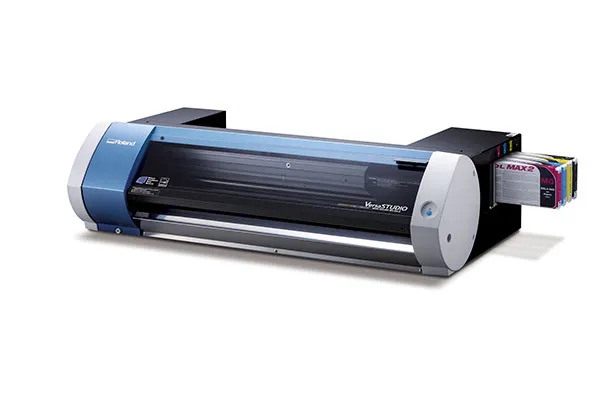
- Pros: Reliable, uses durable eco-solvent inks, prints up to 1440dpi, also doubles as a cutter, fairly easy to maintain
- Cons: Slow cutting speed, rather large size, can’t print white, needs to be in a well-ventilated area
Roland DGA offers two entry-level solutions for small businesses, the first being the BN-20A which was launched in 2021. While it does have a slow print speed compared to some other DTF printers on the market, the BN-20A is still a reliable large-format printer for budget buyers. It may be big, but that big size means it supports film rolls up to 20 inches wide by 50 feet. That means you can print many more designs at the same time!
There are actually two different BN-series printers, with the BN-20A being a slightly more affordable version that only supports CMYK inks and lacks an automatic ink circulation system. In contrast, the BN-20 supports CMYK inks and an additional slot for either white or metallic inks. If you don’t need either of these additional inks (mainly if you’re not printing on dark-colored garments), then the BN-20A will be your best choice.
Additionally, the BN-20A also doubles up as a cutter, adding even more versatility to your print shop’s toolkit. That means you can also print designs for other non-garment applications, including mugs, caps, and even small signage, too. With Roland DGA’s good track record for reliability, you’ll definitely be able to make the most of its capabilities.
The BN-20A’s one other disadvantage is that most of its controls, and the method with which you need to mount your films, are all in the back, so you can’t place it on a table against the wall. It’s ideal to have it mounted on a printer stand (which Roland does sell), but that’s an additional (but necessary) expense.
Roland VersaSTUDIO BN2-20A ($6,495)
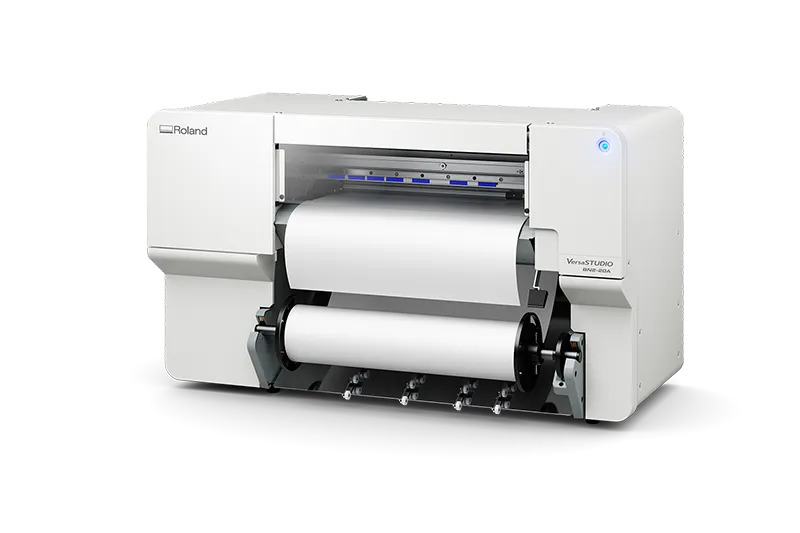
- Pros: Reliable, uses durable eco-solvent inks, faster print speeds, plenty of improvements over the BN-series
- Cons: Slightly higher price tag, slightly larger than the BN-20A
The successor to the BN-series, the BN2-20A shares a number of similarities with the BN-20A – such as supporting CMYK inks only and having integrated print/cut capability – but adds a variety of new features and improvements. In fact, Roland claims the BN2-20A boasts a number of features that make it very easy to operate, even for novices new to DTF printing. This also includes quality-of-life features that make printing a breeze, including the ability to move the base point when printing on printed sheets: no more wasted space or films!
While it is a newer machine, the BN2-20A is larger than the BN-20A. The BN2-20A’s dimensions are 42.1” W × 24.3” D × 24.5” H, while the BN-20A is 39.7” W x 22.9″ D x 11.5″ H in. Given the size difference, you’ll need to sacrifice some real estate in your shop to support one. However, given its wide range of capabilities, it’s a worthwhile tradeoff.
The price point also offers Roland’s proprietary software – the FlexiDESIGNER VersaSTUDIO Edition and VersaWorks 6 Output Software. The former will help you create and manage designs and their output, while the latter helps optimize your print quality, simplify the printing process, and ensure you get great, high-quality prints.
Upgrading to a Mid-Range DTF Printer
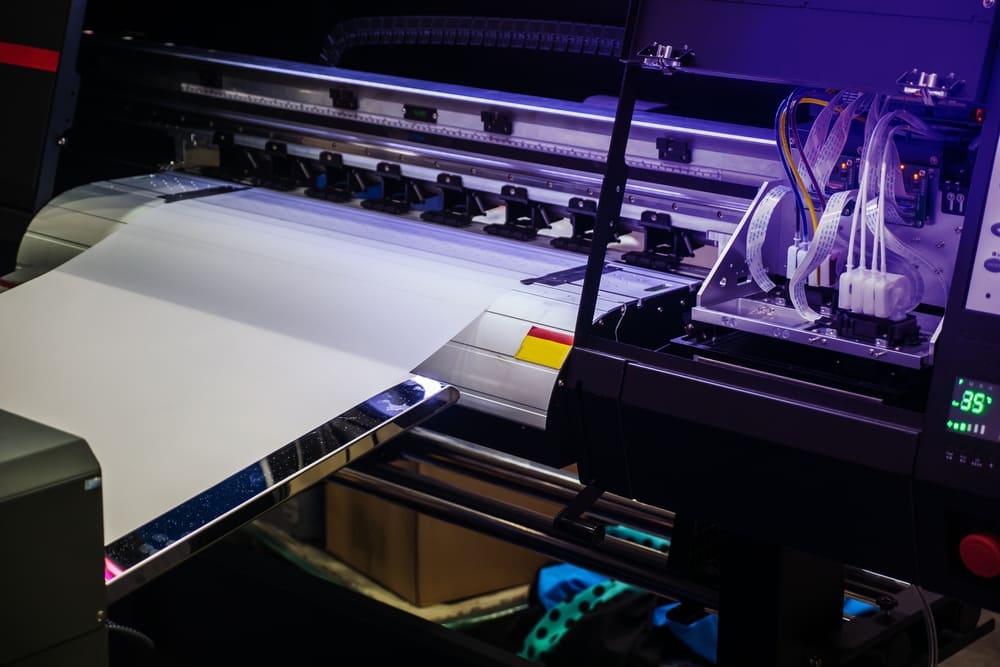
As your print shop’s business picks up, your entry-level DTF printers are going to run into some trouble – specifically, with reliably meeting demand as it steadily increases. DTF does have the advantage that you can print multiple designs on a single sheet, ensuring you make the most of your print times. However, if their print speeds are slow, you’ll still have less time for printing and meeting every order you have pending.
It’s why upgrading to a mid-range DTF printer will be paramount. With a mid-range printer:
- You improve productivity by printing more DTF designs in a shorter span of time
- You reduce downtimes caused by unexpected breakdowns, especially if you’re using converted printers
- You might also improve your print quality either because of higher-quality equipment or inks
You have a number of mid-range DTF printers to choose from, with price ranges going anywhere from $9,000 and above. Most of them provide additional features and equipment, such as integrated powder shakers that make hot melt powder applications more efficient.
Using Your DTG Printer
If you’ve been working with a direct-to-garment (DTG) printer, you can also repurpose your existing DTG printer for DTF applications instead. Is that possible? Yes, indeed! In fact, some manufacturers have provided video tutorials and even support for DTG users to be able to print with DTF instead. That means you won’t have to incur additional expenses to acquire brand-new equipment for transitioning to DTF printing – a big win for your shop’s finances!
Of course, you’ll still need to check with your vendor/manufacturer to determine if your DTG printer can do that. Because DTF transfer films are a lot thinner than regular garments, DTG printers that can adjust the platen’s position and height are best suited for DTF printing, ensuring you can print your design onto the film without problems.
The process is relatively straightforward. You’ll need to place the transfer film onto the platen of the printer, then ensure that the print heads can reach it. As long as this is possible, you’ll be able to print your design without a hitch. Since DTG also uses CMYK inks, you should be able to get similar results when you print it and apply it to a garment. It’s always a good idea to do some testing first before you start printing for your customers.
Conclusion
The best DTF printer for a small business doesn’t need to break the bank, but you’ll need to know what you need, how long you’ll use it, and what kind of applications you intend to fulfill. As your print shop’s business expands, you can start thinking about how you want to upgrade your printing services through more versatile or reliable printers that maximize your productivity and profitability.
